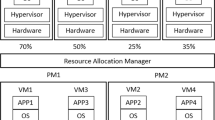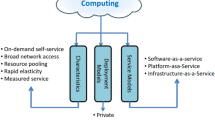Abstract
In order to provide uninterrupted services and fulfill the requirements of customers, Horizontal Cloud Federation Formation (HCFF) has been proposed as a new model enabling cloud providers to cooperate and enlarge their virtual machine infrastructure capacity. In this paper, we have established a synthesis on the main related works in the literature by classifying them into two classes: reactive protocols of HCFF and proactive protocols of HCFF, while doing a comparison between them according to a number of well chosen criteria. Furthermore, we have proposed three protocols of cloud federation formation based on the theory of cooperative games. The protocols are: Sequential Protocol of Horizontal Cloud Federation Formation (SPHCFF), Parallel PHCFF (PPHCFF), and Overlapping PHCFF (OPHCFF). More precisely, our main contribution in this research is the introduction of the notion “Overlapping Federations” with the OPHCFF protocol by referring to the class of Overlapping Coalition Formation Games. Moreover, we have developed a new system of three components based on Inter-Cloud architecture, and then we have implemented it in real time to evaluate the proposed protocols. The obtained experimental results have shown that the OPHCFF protocol improves the average response time, the rate of processed applications, and the profit compared with the introduced PPHCFF protocol. In addition, despite the dissimilarities of architectures, protocols, and mathematical models of existing works, we have arrived to manage a simulation comparison of our SPHCFF with a concurrent mechanism called Cloud Federation Formation Mechanism (CFFM). The obtained simulation results have shown that the proposed SPHCFF performs better than the CFFM mechanism, when the overload rate is large enough, in terms of profit, federation size, time execution, and failure rate.





























Similar content being viewed by others
Change history
30 March 2021
A Correction to this paper has been published: https://doi.org/10.1007/s10586-021-03273-9
Notes
Service Level Agreement is a commitment between a service provider and a client. It defines particular aspects of the service—quality, availability, responsibilities
References
Assis, M.R., Bittencourt, L.F.: A survey on cloud federation architectures: identifying functional and non-functional properties. J. Netw. Comput. Appl. 72, 51–71 (2016)
Ayachi, M., Slimani, H., Nacer, H.: Cooperation based coalition formation in distributed systems. In: 2018 IEEE 5th International Congress on Information Science and Technology (CiSt), pp. 6–11. IEEE (2018)
Belgacem, A., Beghdad-Bey, K., Nacer, H., Bouznad, S.: Efficient dynamic resource allocation method for cloud computing environment. Clust. Comput. 1–19 (2020)
Beri, R., Behal, V.: Cloud computing: a survey on cloud computing. Int. J. Comput. Appl. 111(16), 18 (2015)
Bouchareb, N., Zarour, N.E., Aknine, S.: Intelligent mechanism for cloud federation and requirements changes management. In: Software Engineering Perspectives and Application in Intelligent Systems, pp. 147–157 (2016)
Burakowski, W. et al.: Traffic management for cloud federation. In: Autonomous Control for a Reliable Internet of Services, pp. 269–312. Springer, Cham (2018)
Buyya, R., Ranjan, R., Calheiros, R.N.: Intercloud: Utility-Oriented Federation of Cloud Computing Environments for Scaling of Application Services. Algorithms and Architectures for Parallel Processing, pp. 13–31. Springer, Berlin (2010)
Calheiros, R.N., Ranjan, R., Beloglazov, A., Rose, C.A.F., Buyya, R.: Cloudsim: a toolkit for modeling and simulation of cloud computing environments and evaluation of resource provisioning algorithms. Software 41, 23–50 (2011)
Celesti, A., Tusa, F., Villari, M., Puliafito, A.: How to enhance cloud architectures to enable cross-federation. In: IEEE 3rd International Conference on Cloud Computing (CLOUD), pp. 337–345 (2010)
Chalkiadakis, G., Elkind, E., Markakis, E., Polukarov, M., Jennings, N.: Cooperative games with overlapping coalitions. J. Artif. Intell. Res. 39, 179–216 (2010)
Chen, H., An, B., Niyato, D., Soh, Y.C., Miao, C.: Workload factoring and resource sharing via joint vertical and horizontal cloud federation networks. IEEE J. Sel. Areas Commun. 35(3), 557–570 (2017)
Darzanos, G., Koutsopoulos, I., Stamoulis, G.D.: Cloud federations: economics, games and benefits. IEEE/ACM Trans. Netw. 27(5), 2111–2124 (2019)
Esposito, C., Ficco, M., Palmieri, F., Castiglione, A.: Interconnecting federated clouds by using publish-subscribe service. Clust. Comput. 16, 887–903 (2013)
Ficco, M., Esposito, C., Palmieri, F., Castiglione, A.: A coral-reefs and game theory-based approach for optimizing elastic cloud resource allocation. Future Gener. Comput. Syst. 78, 343–352 (2018)
Goiri, I., Guitart, J., Torres, J.: Characterizing cloud federation for enhancing providers profit. In: IEEE 3rd International Conference on Cloud Computing (CLOUD), pp. 123–130 (2010)
Govil, S.B., Thyagarajan, K., Srinivasan, K., Chaurasiya, V.K., Das, S.: An approach to identify the optimal cloud in cloud federation. Int. J. Cloud Comput. Serv. Sci. 2(1), 35 (2012)
Grozev, N., Buyya, R.: Inter-cloud architectures and application brokering: taxonomy and survey. Software 44(3), 360–390 (2014)
Guazzone, M., Anglano, C., Sereno, M.: A game-theoretic approach to coalition formation in green cloud federations. In: 2014 14th IEEE/ACM International Symposium on Cluster, Cloud and Grid Computing, pp. 618–625. IEEE (2014)
Halabi, T., Bellaiche, M.: Towards security-based formation of cloud federations: a game theoretical approach. IEEE Trans. Cloud Comput. (2018)
Hammoud, A., Mourad, A., Otrok, H., Wahab, O.A., Harmanani, H.: Cloud federation formation using genetic and evolutionary game theoretical models. Future Gener. Comput. Syst. 104, 92–104 (2020)
Hassan, M.M., Hossain, M.S., Sarkar, A.M.J., Huh, E.N.: Cooperative game-based distributed resource allocation in horizontal dynamic cloud federation platform. Front. Inf. Syst. 1–20 (2012)
Jie, Y., Guo, C., Choo, K.K.R., Liu, C.Z., Li, M.: Game-theoretic resource allocation for fog-based industrial internet of things environment. IEEE Internet Things J. 7(4), 3041–3052 (2020)
Kakkad, V., Shah, H., Patel, R., Doshi, N.: A comparative study of applications of game theory in cyber security and cloud computing. Procedia Comput. Sci. 155, 680–685 (2019)
Kansal, S, Kumar, H., Kaushal, Sakshi S.: Cooperative game theory-based request distribution model in federated cloud environment. In: Advanced Computing and Intelligent Engineering, pp. 213–223. Springer, New York (2020)
Lo, N.W., Yeh, K.H., Liu, P.Y.: An efficient resource allocation scheme for cross-cloud federation. In: International Conference on Anti-Counterfeiting, Security and Identification (ASID), pp. 1–4 (2012)
Magaña, A., Carreras, F.: Coalition formation and stability. Group Decis. Negot. 27(3), 467–502 (2018)
Maroc, S., Zhang, J.B.: Cloud services security-driven evaluation for multiple tenants. Clust. Comput. 1–19 (2020)
Mashayekhy, L., Nejad, M.M., Grosu, D.: Cloud federations in the sky: formation game and mechanism. IEEE Trans. Cloud Comput. 3(1), 14–27 (2015)
Myerson, R.B.: Values for games in partition function form. Int. J. Game Theory 6, 23–31 (1977)
Petcu, D.: Multi-cloud: expectations and current approaches. In: ACM Proceedings of the 2013 international workshop on Multi-cloud applications and federated clouds, pp. 1–6 (2013)
Petcu, D.: Consuming resources and services from multiple clouds. J. Grid Comput. 12(2), 321–345 (2014)
Rani, B.K., Rani, B.P., Babu, A.V.: Cloud computing and inter-clouds-types, topologies and research issues. Procedia Comput. Sci. 50, 24–29 (2015)
Ray, B., Saha, A., Khatua, S., Roy, S.: Quality and profit assured trusted cloud federation formation: game theory based approach. IEEE Trans. Serv. Comput. (2018)
Ray, B.K., Saha, A., Roy, S.: Migration cost and profit oriented cloud federation formation: hedonic coalition game based approach. Clust. Comput. 21(4), 1981–1999 (2018)
Saad, W., Han, Z., Basar, T., Debbah, M., Hjorungnes, A.: Coalitional game theory for communication networks: a tutorial. Signal Process. Mag. 26, 77–97 (2009)
Samaan, N.: A novel economic sharing model in a federation of selfish cloud providers. IEEE Trans. Parallel Distrib. Syst. 25, 12–21 (2014)
Saravanan, M., Aramudhan, M., Pandiyan, M., Avudaiappan, S.S.T.: Priority based prediction mechanism for ranking providers in federated cloud architecture. Clust. Comput. 22(4), 9815–9823 (2019)
Toosi, A.N., Calheiros, R.N., Thulasiram, R.K., Buyya, R.: Resource provisioning policies to increase iaas provider ś profit in a federated cloud environment. In: IEEE Computer Society on 13rd IEEE International Conference on High Performance Computing and Communications (HPCC), pp. 279–287 (2011)
Toosi, A.N., Calheiros, R.N., Buyya, R.: Interconnected cloud computing environments: challenges, taxonomy, and survey. ACM Comput. Surv. 47(1), 7 (2014)
Toosi, A.N., Calheiros, R.N., Buyya, R.: Interconnected cloud computing environments: challenges, taxonomy, and survey. ACM Comput. Surv. 47(1), 7 (2014)
Usha, S., Tamilarasi, A.: A trust based security framework with anonymous authentication system using multiple attributes in decentralized cloud. Clust. Comput. 22(2), 3883–3892 (2019)
Yang, J., Jiang, B., Lv, Z., Choo, K.K.R.: A task scheduling algorithm considering game theory designed for energy management in cloud computing. Future Gener. Comput. Syst. 105, 985–992 (2020)
Zhang, H., Xiao, Y., Bu, S., Niyato, D., Yu, F.R., Han, Z.: Computing resource allocation in three-tier Iot fog networks: a joint optimization approach combining stackelberg game and matching. IEEE Internet Things J. 4(5), 1204–12105 (2017)
Acknowledgements
This work has been sponsored by the General Directorate for Scientific Research and Technological Development, Ministry of Higher Education and Scientific Research (DGRSDT), Algeria. Moreover, the authors are thankful to the anonymous referees for their valuable suggestions and comments which have helped to improve the quality of the paper and its presentation.
Author information
Authors and Affiliations
Corresponding author
Additional information
Publisher's Note
Springer Nature remains neutral with regard to jurisdictional claims in published maps and institutional affiliations.
The original online version of this article was revised: Figures 12 to 24 are mismatched, so it has been replaced with the correct figures.
Rights and permissions
About this article
Cite this article
Ayachi, M., Nacer, H. & Slimani, H. Cooperative game approach to form overlapping cloud federation based on inter-cloud architecture. Cluster Comput 24, 1551–1577 (2021). https://doi.org/10.1007/s10586-021-03253-z
Received:
Revised:
Accepted:
Published:
Issue Date:
DOI: https://doi.org/10.1007/s10586-021-03253-z




